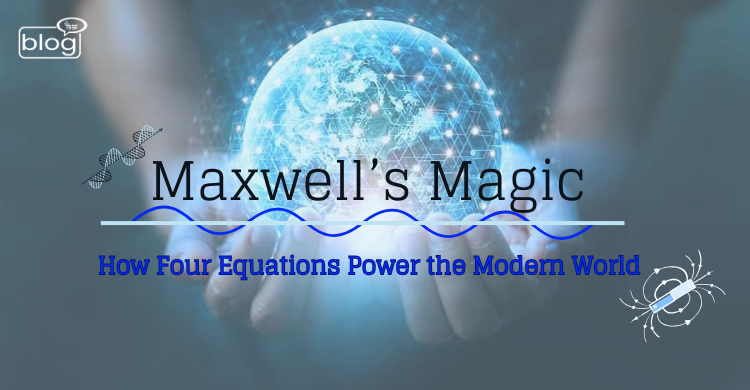When we switch on a light, connect to Wi-Fi, or place a call on our phones, we don’t give much thought to the invisible rules that govern the electricity and magnetism that drive them. Yet over 150 years ago, James Clerk Maxwell gave us a set of four elegant equations on which our whole electrical world is founded. They’re known as Maxwell’s Equations, and they’ve transformed the world in ways that their creator could maybe never have imagined.
The Unification Genius
It was Maxwell before whom electricity and magnetism were treated as distinct phenomena. Benjamin Franklin and others had experimented with electricity; Michael Faraday had broken new ground in experimenting with magnetism and induction. But it was Maxwell who consolidated their results into a single theory that proved: electricity and magnetism are two aspects of one force—electromagnetism.
Maxwell’s Four Equations, expressed using vector calculus, inform us regarding the interaction and transmission of electric and magnetic fields. Although they may look intimidating, the ideas in them are not so complicated and are very profound. Let us grasp them one by one in simple terms.
- Gauss’s Law for Electricity
Statement: Electric charges generate electric fields.
Practical application in real life: The law instructs us on how a charged body can influence things around it, even from a distance.
Imagine rubbing a balloon against hair and having it attract pieces of paper. Static electricity creates an electric field that produces a force over space. Gauss’s Law tells us that the strength of the field depends upon the amount of charge enclosed. It’s how capacitors operate, storing energy in virtually all electronic devices.
- Gauss’s Law for Magnetism
Statement: Magnetic monopoles do not exist; magnetic field lines always close in on themselves.
Real-world implication: You cannot have a single-pole magnet.
Unlike electric charges, you can’t divide a north or south pole of a magnet. Even if you cut a magnet in half, you just have two smaller dipoles. This law keeps our understanding of magnetism symmetric and explains compasses functioning, since Earth’s magnetic field is also a closed loop.
- Faraday’s Law of Induction
Statement: A changing magnetic field induces an electric field.
Real-world application: This is how we generate electricity.
Every time you plug something into an electric socket, thank Faraday’s Law. It explains how electric generators work: by rotating coils within magnetic fields (or vice versa), we induce a current. This is the principle that powers the electric grid, turning mechanical energy into electrical energy.
- Ampère-Maxwell Law
Statement: A current or a changing electric field produces a magnetic field.
Real-world application: This law helps to describe electromagnets and even Wi-Fi.
Maxwell added an important phrase to Ampere’s original law to prove that a fluctuating electric field (even in the absence of a current) could produce a magnetic field. The mechanism behind light, radio, microwaves, and other devices, electromagnetic waves, was made possible by this.
From Equations to Electromagnetic Waves
When Maxwell combined these four equations, he found something astounding: light itself is an electromagnetic wave. It then followed that visible light, X-rays, infrared radiation, radio waves, and microwaves were all the same thing, only differing by frequency.
This breakthrough transformed physics and led directly to radio communication, television, radar, fiber optics, and the whole world of wireless. Indeed, without Maxwell’s contributions, there would be no contemporary telecommunications, no internet, and no smartphones.
Impact Beyond Physics
Maxwell’s Equations are not just useful tools to scientists and engineers; they are an achievement of the human mind. They are beautiful because they are simple and unified. They show us that nature is governed by precise rules—rules which we can understand, manipulate, and use to build technologies that improve our lives.
In the classroom, they are the basis for electromagnetism lessons. These guide the development of novel materials, electrical circuits, and antennas in the lab. They help us understand how solar storms in space affect Earth’s magnetic field. In medicine, they enable imaging technologies like MRI.
Why Students Should Care
For the student, especially the student of science, technology, engineering, and math (STEM), studying Maxwell’s Equations is not so much an exercise in taking a test—it’s learning to uncover the invisible threads that weave our technological universe. Whether you’re designing circuits, studying wave propagation, or even building communications satellites, these four laws are your map.
James Clerk Maxwell’s equations are theoretical, yet their impact is concrete in every phone call, every electric car, and every Wi-Fi connection. They inform us that a few lines of mathematics, once they are well understood, have the power to change the universe.
In an age where technology is all around us, understanding the principles behind it puts us in charge of not just using it, but shaping its future. And it all begins with four equations.
To read these types of blogs, click here.
Writer
Umme Farhana Sumaiya,
Intern, Content Writing Department
YSSE

